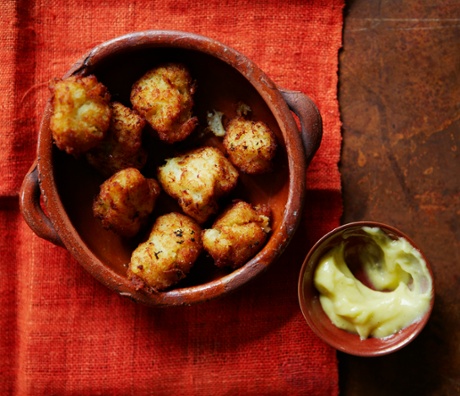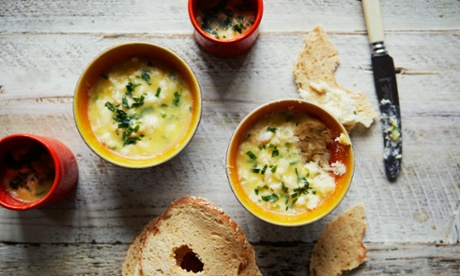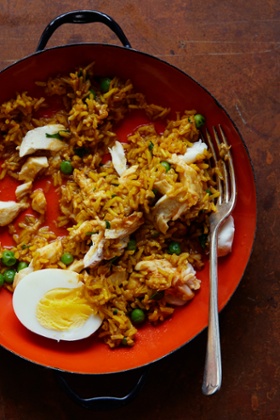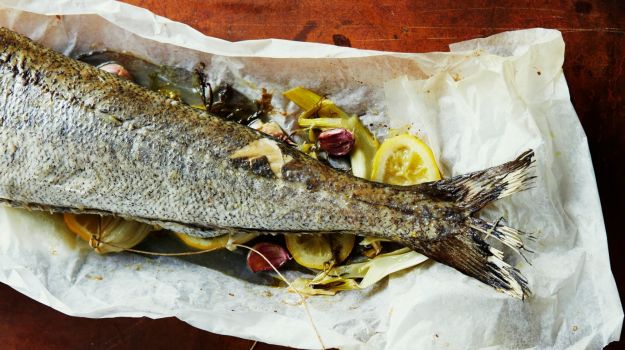‘Bake a hake: a fish ‘en papillote’ with fennel and lemon to start you off... Photograph: Yuki Sugiura for the Guardian.The leftovers of a succulent whole fish, cooked in a parchment parcel for supper, can be turned into three more delicious dishes: crisp croquettes, a light pâté, and a flavourful kedgeree.It’s true that a whole fish can be rather daunting: guts, scales, fins and eyeballs to stare back at you. But the fact is, fish cooked on the bone – just like meat – is more succulent, moist and flavourful, and provides a brilliant centrepiece for any meal. Gurnard, pouting, pollock, hake (pictured) or coley are all good sustainable choices with a nice quantity of meat and round frame. Buy line-caught fish whenever possible as it’s a low impact fishing method and also unfortunately one of the only fishing methods advertised by a fishmonger. I’d always recommend shopping at your local fishmonger, but when shopping in the supermarket look for the Marine Stewardship Council’s MSC stamp of sustainability.
Any fish left on the bone after the main event can be kept to use in any (or all) of the following three recipes. After your meal, clean all the flakes of meat off the carcass. It will store in a sealed container for up to five days in the refrigerator.
The main event: Fish en papillote with fennel and lemon (pictured above)
A simple way to cook a whole fish is sealed and wrapped inside parchment, or “en papillote”. The parcel acts as a mini oven, steaming the fish and helping to keep it very moist. All the flavours trapped in the bag infuse with the meat. This method will work with all whole fish, although cooking times will vary depending on the size.
Serves 5-7
1.5-2kg whole round fish, gills removed, gutted and scaled
1 unwaxed lemon, sliced into rounds
4 garlic cloves, crushed, with skin on
1 bulb fennel, cut in half and thinly sliced
Extra virgin olive oil, to taste
Salt and black pepper
Potatoes, salsa verde and or aioli to serve (optional)
1 Preheat the oven to 180C/350F/gas mark 4. Tear off a piece of parchment that’s roughly 2½ times the length of your fish. Create a bed of lemon, garlic and fennel slices along the middle of the parchment. Lay the fish on top of this bed, then stuff the cavity with some of the fennel and garlic.
2 Drizzle some olive oil over the fish and season with plenty of salt and black pepper. Fold in the ends of the parchment, then pull it up around the fish. Fold the edges together to form a sealed bag.
3 Put the fish parcel into the oven for 25 minutes for the first 1kg, then 5 minutes for each extra 500g. A 2kg fish, for example, should take about 35 minutes to cook, but all fish are slightly different in shape, so some may take a little longer. To check the fish is cooked properly, remove it from the oven, unwrap the parchment – being careful of the steam – and prise the flesh away from the bone at the thick end of the neck. If it pulls away, it is ready to eat. Serve as a centrepiece with the fennel, some potatoes and salsa verde or aioli.
The tasty tapa: Fish and potato croquettes
We serve these croquettes by the dozen in my restaurant, Poco. They are quick to make and satisfying to eat.

Makes 12-15
300g floury potatoes, such as a desire or king edward, skins on
½ small onion, grated, strained
2 sprigs parsley, leaves roughly chopped, stalks finely chopped
A small pinch of chilli flakes
200g leftover fish flakes or cooked white fish
1 small egg
1½ tbsp wholemeal or plain flour
500ml oil, for frying
Sea salt
Lemon wedges, to serve
1 Boil the potatoes for around 20 minutes, or until tender. Drain, allow to cool a little, then peel off the skins.
2 Mash the peeled potatoes with the grated onion, parsley leaves and stalks, chilli flakes and flour, then stir in the fish and egg with a generous amount of seasoning. You can prepare the croquettes up to this stage in advance.
3 When you are ready to eat, put the oil into a saucepan, making sure the oil doesn’t reach higher than ⅓ of the way up the sides. Put on a medium-high heat and bring up to 160-170C/320‑340F. Test to see if the oil is hot enough by dropping a tiny piece of the mixture into the oil. If it bubbles and rises to the top, it’s ready. Carefully place large teaspoons of the mixture into the oil. Fry for 3-5 minutes, turning them if necessary. When the croquettes are golden brown remove them from the oil and rest on a piece of kitchen roll. Season with sea salt and serve with wedges of lemon.
The light lunch: Potted fish pâté topped with tarragon butter
This is a snappy way to preserve fish leftovers and make them into something perhaps even more tasty than the original dish. This method preserves the fish for a good week, sealed by a cap of butter on top. Eat on brown toast as a simple snack. Some recipes call for extra seasonings of mace, allspice and nutmeg but I find these spices overkill. Such delicious flavours need little else.

Serves 2
100g butter
1 sprig tarragon, picked, chopped
200g flaked fish
Juice of ½ lemon or splash of vinegar
Sea salt and black pepper
1 Melt the butter with the tarragon leaves in a frying pan over a very low heat. Pour half of it over the flaked fish, along with the lemon juice or vinegar, if using, as well as a good pinch of salt and pepper, then mix well.
2 Find a small ceramic pot or jar big enough to contain the fish. Press the fish into the jar and smooth the top with the back of a spoon. Pour the remaining butter on top to seal the fish inside.
The substantial brunch: Kedgeree
This is my perfect brunch; healthy, sustaining and deeply full with flavour. Kedgeree is usually made with smoked haddock, but adapts well and can be made using any flaked white fish. I’ve added some smoked paprika to the recipe to give it the smokiness it needs.

Serves 2
A generous splash of light olive oil
1 small onion, finely chopped
2 garlic cloves, roughly chopped
3 sprigs parsley, leaves roughly chopped, stalks finely chopped
1 tsp curry powder
1 tsp smoked paprika
1 tsp turmeric
Sea salt and black pepper
150g brown basmati rice
450-500ml fish stock or water
200g leftover flaked fish or cooked smoked haddock
50g peas
A squeeze of lemon juice, plus ∫ lemon, cut into two wedges, to serve
1 hard boiled egg
Yoghurt, to serve
For the stock (makes 1 litre)
1 small white onion, roughly sliced
1 stick celery, roughly sliced
1 small carrot, roughly sliced
1 clove garlic, crushed
3 parsley stalks
1 large fish skeleton and fish head (gills removed)
1 bay leaf, 1 tsp of coriander seeds, black peppercorns, mustard seeds
1 First, make the stock. Place all the ingredients into a large saucepan, push them down to make sure they are compact. Cover with at least one litre of water, making sure the ingredients are more or less covered. Bring to a simmer making sure it doesn’t boil as this can make your stock overly cloudy. Simmer gently for half an hour, skimming any particles from the top as they appear. Remove from the heat and allow to cool. Strain through a sieve keeping the liquid. Store in the fridge for up to five days.
2 Next, heat the oil in a saucepan over a medium heat, then add the onion and fry gently for 5 minutes, stirring.
3 Add the garlic, parsley stalks, spices and 1 tsp salt. Fry for 2 minutes.
4 Add the rice and stir to coat the grains in the spiced oil and onions.
5 Add the fish stock, place a lid on top and bring to the boil. Reduce to a gentle simmer for 25-30 minutes. Check to see if the rice is cooked every now and again to make sure it doesn’t boil dry – add a touch more stock or water, if necessary.
6 When the rice is cooked remove from the heat, stir in the fish, peas, parsley leaves and a generous squeeze of lemon. Adjust the seasoning, adding plenty of black pepper. Serve with half a boiled egg and lemon wedges.
Tom Hunt is an eco-chef, director of Poco restaurant in Bristol and author of The Natural Cook (Quadrille)








